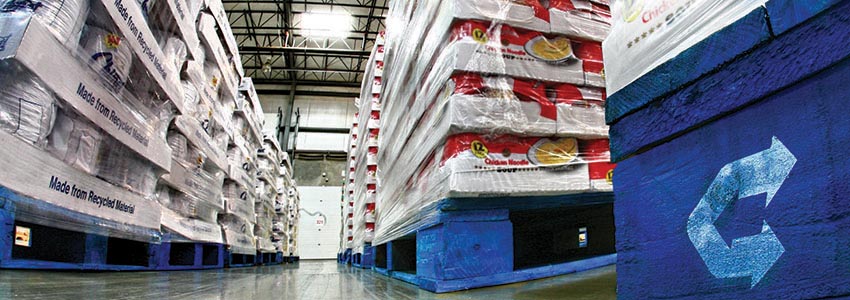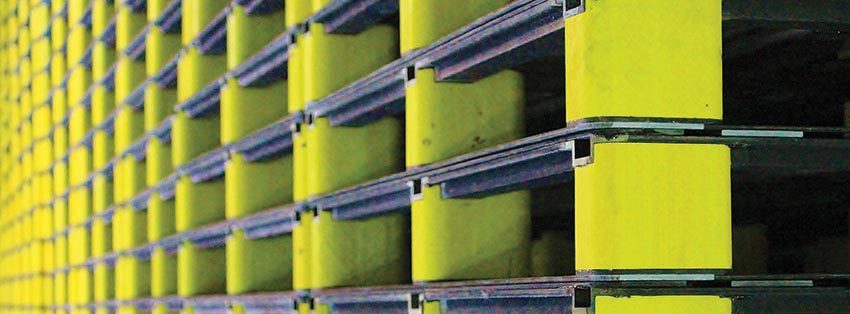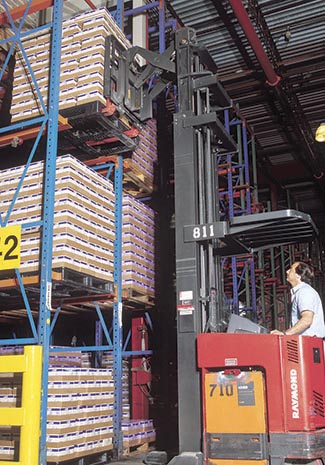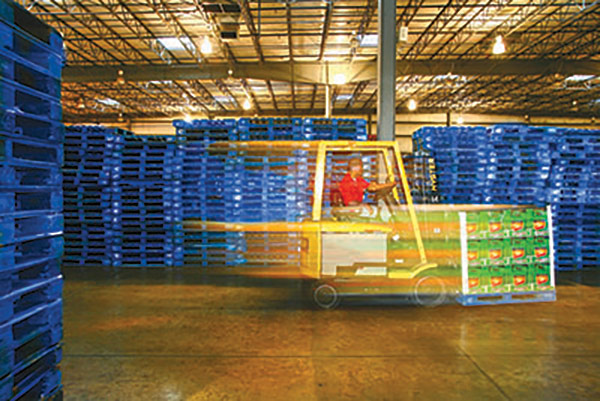Equipment Report: The Modern Pallet
Pallets, one of the oldest links in the supply chain, are poised to deliver far more than product as they evolve into a connected world.
Technology has transformed the modern supply chain into something that would be virtually unrecognizable to an industry professional from 1999. Yet, since World War II, when Norman Cahners, the founder of Modern Materials Handling, invented the four-way pallet, pallets have remained largely unchanged and support the majority of material movements worldwide.
Reusable alternatives to conventional wood pallets have gained some traction, but they remain difficult to manage or justify outside well-defined applications. Meanwhile, radio frequency identification (RFID) technologies have had limited success adding a layer of data and visibility to the movements of pallets.
But, data is king in the modern supply chain, and pallets are positioned to capture the data that underlies, well, everything. The pallet of the near future is not merely a trackable asset, or a slight improvement in sustainability: Industry experts say it will serve as a kind of micro-warehouse, providing real-time, detailed information about its contents, their temperature, surrounding conditions and more. The pallet might soon emerge as a key starting point for supply chain design.
“Information about a pallet’s location, mechanical stresses and other environmental factors all rolls into Big Data, and there’s a huge opportunity to sell that data—which is much more valuable than the pallet itself,” says Mark White, president of White & Co. “The pallet is in a great position to generate valuable data about the supply chain.”
Companies are starting to embrace this philosophy, says David Kalan, vice president of marketing and business development for RM2. “The industry is taking the pallet from necessary evil to necessity,” Kalan says. “It will be the center for gathering supply chain data that will give very accurate information, allowing companies to make better decisions and improve everything from inbound raw materials through production through storage, delivery and all the way to the consumer. The connected pallet will speed the supply chain, cut inventory levels and at the end of the day make more money.”

This transformation will require more than technology, though, because the purchasing, usage and disposal of pallets is entrenched in old practices. To realize the potential benefits, stakeholders throughout the supply chain will need to change how they think about the pallet’s role in their businesses.
Pallets and supply chain design
The pallet is so essential that Mark White, president of White & Co, counts it among the three main components of any supply chain: pallets, packaging and all of the equipment used to move them.
“The key to optimizing is understanding how those three components interact,” White says. “I teach my students that they can either find the problem and troubleshoot it, or they can make a brand new supply chain.”
The first step is to audit the supply chain from manufacturing to distribution to retail, precisely documenting and measuring all packaging, pallets and every piece of handling equipment like conveyors and forklifts. Then, analyze the results by looking for stress points in the supply chain that are dictating pallet and packaging design.
Stresses hit a maximum at multiple points in the supply chain and designers have to account for that. But before trying to find a way to optimize the whole supply chain, it’s worthwhile to look at what might be done to reduce those stresses, for instance by changing the type of conveyor. More frequently, product packaging is where the largest savings are found, since most companies spend two to 50 times as much money on packaging as on the pallet itself.
Packaging changes begin with pallet changes. Whenever packages are unitized on top of a pallet, it’s critical to design the packaging for the maximum compression stress each package might endure. That starts by changing the pallet. For example, a pallet deck might be stiffened through the addition of another stringer, or by specifying the right plastic pallet.
“In virtually every case, it’s possible to save 8% to 18% on packaging spend,” White says. “There are even greater savings, however, in the resulting storage efficiencies, shipping efficiencies and reduced product damage.”
Once the data is audited and analyzed, it’s time to design a solution. Software can help optimize and model how components interact. After field tests and a final round of tweaks, it’s time to implement based on the knowledge gained from the full audit of the entire supply chain. The results, White says, can be dramatic.
White recalls the experience of a large wall and floor covering company that was spending a lot on plastic pails. The company wanted to stack pails three-high and ship directly to big box stores, but pails were frequently damaged in transit due to high compression stresses generated by pallet deformation. The company initially considered stronger plastic pails, since an increased spend on pallets seemed like a nonstarter.
Instead, the company ran the numbers on transitioning from the 90-mil pail to a less expensive 80-mil pail, which would save $9 per unit load. A redesigned pallet cost another $1.70 apiece, netting $7.30 in savings for each load. The company saved $380,000 in the first year of the program.
White admits that although the math is easy, setting the wheels in motion for such an initiative is not.
“The roadblocks are politics,” he says. “This project worked because the head of corporate purchasing got the go-ahead from the head of corporate logistics. When one agent is responsible for pails and another for pallets, as was the case here, there can be problems. You’re asking pallets to go up by 10% when they have a mandate to cut by 4%. You have to have someone above them both who will not penalize either of them, and will in fact reward them for a team effort.”

Supporting new business models
It’s not just pallet users facing this challenge. Pallet providers are also exploring how their business models can change.
“About three years ago we realized that, yes, we provide pallets, but when we actually work with customers we have a lot of broader conversations,” says Todd Hoff, vice president of marketing and customer solutions for CHEP’s North American business. “The pallet might be the enabler, but we spend a lot of time making the supply chain more efficient. All the data on the pallet and its movement helps us think about the supply chain very differently.”
For example, CHEP worked with a leading meat processor to make its network more efficient by reducing empty truck miles. The customer operates more than 600 trucks from five freight terminals across the United States. By purchasing the customer’s empty miles, CHEP found a cost-effective solution to move pallets while opening another revenue stream for its customer. Over 12 months, the collaboration eliminated 880,000 empty truck miles, resulting in a reduction of more than 3.3 million pounds of CO2 emissions.
“They are our customer, but we also work with them to coordinate transportation flows,” Hoff says. “By using their empties, we cut all those miles and CO2 just by not having a traditional customer/supplier relationship and exploring joint opportunities.”
Hoff says CHEP has forged similar relationships with both manufacturers and retailers. Because CHEP is one of the largest backhaul shippers with more than 40,000 lines, they are compelled to increase usage and reduce waste whenever possible.
“I always encourage people to step all the way back and look at the entire supply chain,” Hoff says. “Identify those key areas, and you start to see trends like issues around transport efficiency, waste reduction, automation and forecasting. Today we’re engaging more up front and having discussions about new platforms before we even talk about designs. Customers don’t see pallets as a reactionary decision, and they are ready to talk early about these strategic concerns.”
Decks with data
Operations using or evaluating automation will be among the first to revisit their assumptions about pallets. The vast majority of the pallet market is wood, whose irregularities can wreak havoc in precisely engineered automated solutions. A wood chip here, a missing stringer there, or a half-inch too short or long and disruptions will arise. Plastic pallets offer more predictability, but dimensions and load capacity are just the starting points for any optimal pallet specification.
“The first spec people look for is strength, but you can’t stop there,” White says. “A 48 x 40-inch pallet at 2,000 pounds is not enough information to optimize. What about stiffness, the location of the deck boards, and how they interface with packaging? These functionality characteristics need to be taken into account. So many companies come up with the lowest-cost pallets that meet two sets of criteria only to waste money as that pallet interacts through the supply chain.”
Ryan Roessler, product manager at Orbis, emphasizes the level of detail required for a true understanding of the pallet’s end-to-end journey. What are the shipping and storing requirements? Will the pallet be loaded with bags or fluids, or a columnar load? What types of racking will be used? Will the pallet be stored in a freezer or in extreme heat? Especially when designing a plastic pallet, these factors are essential to determining the right plastic formula to achieve optimal performance.
“We try to educate customers on opportunities to change some of the things they’ve done out of habit,” Roessler says. “Many will come to us and say they need a pallet that can rack 3,000 pounds, when 95% of time they only need 2,200. Is there an opportunity to handle that 5% differently?”
Such a change could require new processes and pallet management techniques in a given facility, but there are always tradeoffs, Roessler says. Right now, the differing requirements from one supply chain node to another cause inefficiencies that would benefit from an analysis of potential tradeoffs. For example, the pallet used for transport from manufacturer to distributor often prioritizes capacity and racking strength. Then, from distributor to retail location, pallets are expected to handle lighter loads, and features that reduce weight and space usage are ideal.
 “A complete ROI analysis can reveal those hidden costs,” Roessler says. “If a customer has product arrive on wood, but they can only ship it out on plastic, there is a labor cost to downstack and transfer. Can that customer convert their supplier to plastic to eliminate that extra labor? It might even make sense for the customer to buy the pallets for that loop and give them to the supplier.”
“A complete ROI analysis can reveal those hidden costs,” Roessler says. “If a customer has product arrive on wood, but they can only ship it out on plastic, there is a labor cost to downstack and transfer. Can that customer convert their supplier to plastic to eliminate that extra labor? It might even make sense for the customer to buy the pallets for that loop and give them to the supplier.”
Once pallets are deployed, another challenge is keeping track of them. Kalan describes a new family of devices embedded in the center block of a pallet that can communicate with AT&T’s new LTE-M network. RM2’s solution and others like it can collect detailed data and submit it to the Cloud from virtually anywhere in 200 countries.
In addition to reporting information like latitude, longitude and time stamps, these devices partner with others, including humidity and temperature sensors, allowing a company in Africa to verify the cold chain as a pallet of refrigerated goods travels to India. In another example, one company shipping tomatoes from Mexico determined the product encountered 10 touch points before it hit the shelf. But they had no idea how much time product spent at each touch point. Once they identified that tomatoes spent six hours at one touch point, they could take steps to cut that to three. If that company speeds the delivery by just one day, Kalan says, it will save $3.5 million a year.
“With all this information, the necessary evil becomes the brains of the supply chain,” Kalan says. “It is with your product until it is delivered, and what better way to find out what’s going on with your product than the pallet?”
The concept of using a network like AT&T effectively bypasses the need to set up infrastructure, Kalan says. As soon as a device is activated, it begins reporting. Although designed to last longer than the 150-cycle lifespan of some reusable pallets, Kalan says the devices could theoretically offer valuable data for wood pallets as well.
“The modern pallet is here, and it is affordable,” Kalan says. “That’s the message we and our competitors need to get out. We’re able to achieve a price-per-trip at or within a couple percent of wood prices. As we grow our pool and recovery efficiencies and reverse logistics increase, those prices will only drop.”
Companies mentioned in this article:

Article Topics
Equipment Report News & Resources
Radial stays ahead of the automation curve Wireless Mobility: Ready for the next leg up AGVs set new standards for inventory transportation Inside North Shore Care Supply: Bringing robots to receiving Bergen Logistics: Putting robots to work in a multi-tenant facility High-tech meets low-tech: Automate storage for pallet loads Tuggers, carts work together to increase productivity and ergonomics More Equipment ReportLatest in Materials Handling
Registration open for Pack Expo International 2024 Walmart chooses Swisslog AS/RS and software for third milk processing facility NetLogistik partners with Vuzix subsidiary Moviynt to offer mobility solutions for warehouses Materials Handling Robotics: The new world of heterogeneous robotic integration BSLBATT is looking for new distributors and resellers worldwide Lucas Watson appointed CSO for Körber’s Parcel Logistics business in North America Hyster recognizes Dealers of Distinction for 2023 More Materials HandlingAbout the Author
Subscribe to Materials Handling Magazine

Find out what the world's most innovative companies are doing to improve productivity in their plants and distribution centers.
Start your FREE subscription today.
April 2024 Modern Materials Handling

Latest Resources












